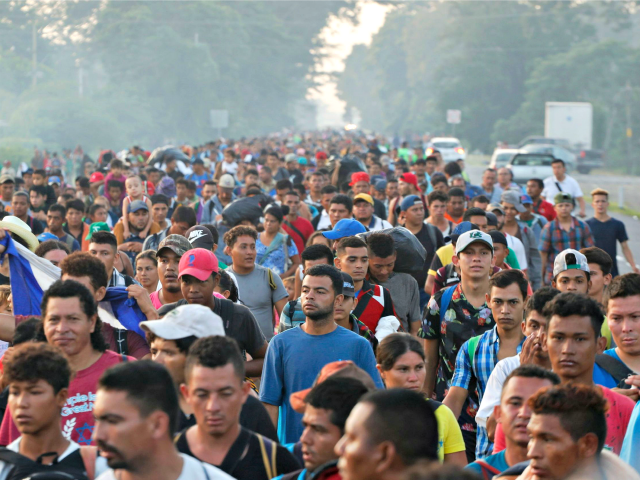Legal and illegal migrants sent $53.4 billion in remittances back to Mexico and Central America in 2018, or more than double the cost of building a border barrier on the U.S.-Mexico border, according to a World Bank report.
Remittances to Mexico reached $33.7 billion in 2018, up 21 percent from roughly $27.8 billion in 2016, the bank reported.
Remittances from the three Central Americans countries are being spiked by the growing inflow of asylum-seeking migrants into blue-collar jobs throughout the U.S. economy, via the border’s catch-and-release laws. The outflow to Central America rose to $19.7 billion in 2018, up from $15.8 billion in 2016, according to the bank.
The outflow to Central America rose 25 percent in just two years.
GOP legislators have urged Congress to pay for the $22 billion border wall by taxing migrants’ remittances.
The money sent back from the United States to Central America includes many migrants’ payments to the cartels who traffic them into the U.S. economy. The trafficking debts can start at $5,000 per head.
The remittances provide a huge stimulus to the countries that export their populations to the U.S. labor market. But that stimulus also imposes huge economic costs, including civic turmoil, poverty, high rates of crime, and loss of foreign investment.
The Guardian reported from Guatemala:
In impoverished villages such as Yalambojoch, agriculture is the only work available.
Such grinding poverty makes emigration an attractive alternative, according to the town’s mayor, Lucas Pérez. “People leave our village, find work in the US and send money to help their relatives,” said Pérez, who estimated about 200 people from the tiny village live in the United States.
The surrounding Huehuetenango province sends the largest number of migrants from the country, according to Guatemala’s foreign ministry, and evidence of the exodus is clear: Yalambojoch has no potable water or electricity, but among the wooden shacks are modern two-story houses with tiled roofs – built with remittance money from abroad.
Dale L. Wilcox, the executive director at the Immigration Reform Law Institute, explained the damage caused by migration:
The Organization for the Americas … cited El Salvador as the worst hit, noting that “one out of every five Salvadorans currently lives outside of the country [which has] provoked a parallel exhaustion of qualified human resources.” This, they say, had caused “a scenario in which less than 11 percent of Salvadorans [have] tertiary education.” Draining an already underdeveloped nation of its best and brightest reduces any prospect of establishing a knowledge-based economy, and disincentivizes their political elite from investing in sorely needed educational infrastructure.
This damage adds up to intellectual colonialism, in which the superpower to the north plunders and loots the skilled labor from its poorer neighbors and condemns them to a bleak future.
Wilcox also noted the impact on families:
Mexico-based journalist Robert Jay Stout shows that a full 12 percent of Mexico’s adult population is now in the United States, according to 2010 census numbers. Such mass outmigration, he found, has contributed to 40 percent of Mexico’s rural towns and villages suffering a population loss as high as 70 percent. Whole communities were uprooted.
The ongoing exodus has resulted in a dramatic increase in the number of single-parent families, homeless, and runaway children — allowing gang membership to proliferate, he says.
Nationwide, the U.S. establishment’s economic policy of using legal migration to boost economic growth shifts wealth from young people towards older people by flooding the market with cheap white-collar and blue-collar foreign labor. That flood of outside labor spikes profits and Wall Street values by cutting salaries for manual and skilled labor of blue-collar and white-collar employees.
The cheap labor policy widens wealth gaps, reduces high tech investment, increases state and local tax burdens, hurts kids’ schools and college education, pushes Americans away from high tech careers, and sidelines at least five million marginalized Americans and their families, including many who are now struggling with fentanyl addictions.
Immigration also steers investment and wealth away from towns in Heartland states because coastal investors can more easily hire and supervise the large immigrant populations who prefer to live in coastal cities. In turn, that investment flow drives up coastal real estate prices, pricing poor U.S. Latinos and blacks out of prosperous cities, such as Berkeley and Oakland.

COMMENTS
Please let us know if you're having issues with commenting.